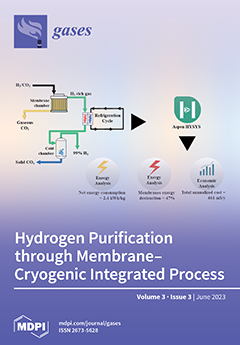Nutshells are regarded as cost-effective and abundant raw materials for producing activated carbons (ACs) for CO
2 capture, storage, and utilization. The effects of carbonization temperature and thermochemical KOH activation conditions on the porous structure as a BET surface, micropore volume, micropore width,
[...] Read more.
Nutshells are regarded as cost-effective and abundant raw materials for producing activated carbons (ACs) for CO
2 capture, storage, and utilization. The effects of carbonization temperature and thermochemical KOH activation conditions on the porous structure as a BET surface, micropore volume, micropore width, and pore size distribution of ACs prepared from walnut (WNS) and hazelnut (HNS) shells were investigated. As a result, one-step carbonization at 900/800 °C and thermochemical KOH activation with a char/KOH mass ratio of 1:2/1:3 were found to be optimal for preparing ACs from WNS/HNS: WNS-AC-3 and HNS-AC-2, respectively. The textural properties of the WNS/HNS chars and ACs were characterized by low-temperature nitrogen vapor adsorption, XRD, and SEM methods. Dubinin’s theory of volume filling of micropores was used to evaluate the microporosity parameters and to calculate the CO
2 adsorption equilibrium over the sub- and supercritical temperatures from 216.4 to 393 K at a pressure up to 10 MPa. The CO
2 capture capacities of WNS- and HNS-derived adsorbents reached 5.9/4.1 and 5.4/3.9 mmol/g at 273/293 K under 0.1 MPa pressure, respectively. A discrepancy between the total and delivery volumetric adsorption capacities of the adsorbents was attributed to the strong binding of CO
2 molecules with the adsorption sites, which were mainly narrow micropores with a high adsorption potential. The high initial differential heats of CO
2 adsorption onto ACs of ~32 kJ/mol confirmed this proposal. The behaviors of thermodynamic functions (enthalpy and entropy) of the adsorption systems were attributed to changes in the state of adsorbed CO
2 molecules determined by a balance between attractive and repulsive CO
2–CO
2 and CO
2–AC interactions during the adsorption process. Thus, the chosen route for preparing ACs from the nutshells made it possible to prepare efficient carbon adsorbents with a relatively high CO
2 adsorption performance due to a substantial volume of micropores with a size in the range of 0.6–0.7 nm.
Full article



